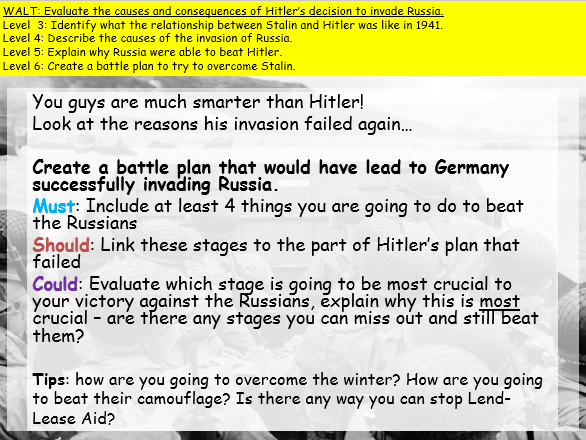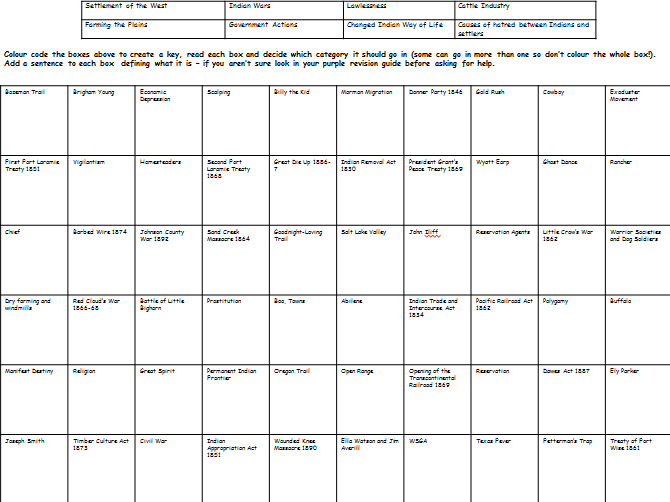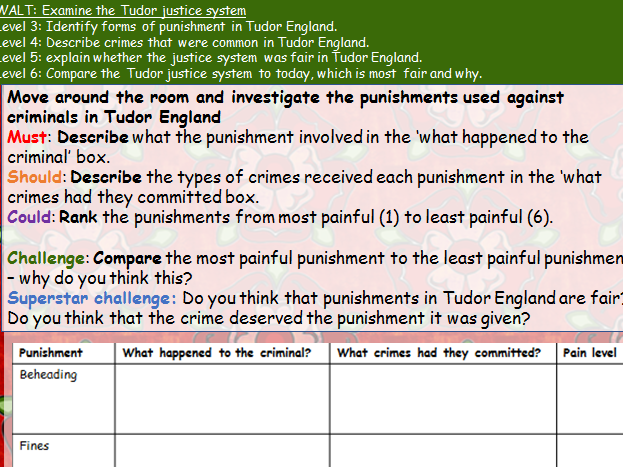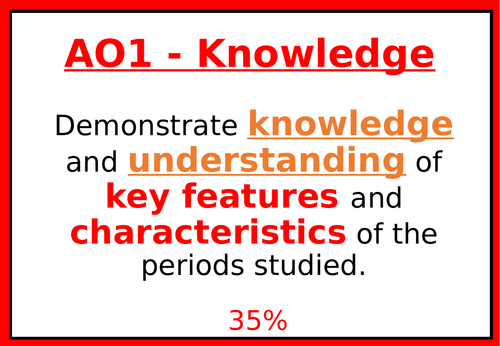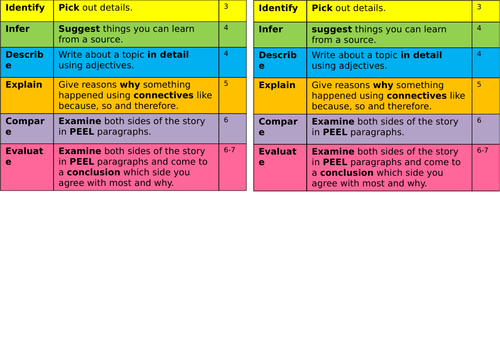
177Uploads
66k+Views
22k+Downloads
All resources

WW1 Medicine Revision Session (Edexcel 9-1)
Session covers the Western Front section of the Edexcel history 9-1 course.
Pupils cover:
features of a trench
features of the main battles
key medical problems
key medical advances
blood transfusions and x-rays (problems and solutions)
following up a source

Weimar and Nazi Germany Timeline and Lesson (Edexcel 9-1)
Timeline with sections for pupils to create - worksheet to support.
Fully differentiated lesson to go alongside the timeline.
Starter: structure of Paper three
task one: overview video
Task two: timeline - defining key words, describing key events and extension task
Whiteboard AFL
Task Three source work - why vote for hitler? challenge: making links to key events on the timeline
Task designed as an introductory lesson to paper three to give pupils an overview of the topic so assumes no prior knowledge but could also be used as a revision task.

Henry VIII Wives
Full lesson and homework. Pupils evaluate which wife Henry loved most by firstly completing a carousel activity that allows them to explore each wife and the reasons Henry divorced her before creating an extended writing piece (differentiated) about who he loved most.
Homework: to write a letter to the Pope explaining why you want a divorce from Katherine of Aragon.
WALT: Evaluate who Henry loved most.
Level 3: Identify Henry’s six wives.
Level 4: Describe each of his wives and what happened to them.
Level 5: explain why Henry divorced each wife.
Level 6: Compare which wife was Henry loved most, give reasons why.

KS3 Operation Barbarossa (WW2)
Pupils will:
Analyse a source to suggest what the relationship was like between Hitler and Stalin
describe two reasons Hitler chose to invade Russia - guided questions on the PPT for support
suggest what Britain should do - four options to engage pupils before they discover Churchill’s speech as a response
Explain why Stalin was able to beat Hitler - rank a worksheet and then explain one in detail.
create a battle plan as if they are Hitler, what could they have done to beat Stalin?
WALT: Evaluate the causes and consequences of Hitler’s decision to invade Russia.
Level 3: Identify what the relationship between Stalin and Hitler was like in 1941.
Level 4: Describe the causes of the invasion of Russia.
Level 5: Explain why Russia were able to beat Hitler.
Level 6: Create a battle plan to try to overcome Stalin.

REVISION American West Thinking Quilt (Edexcel 9-1)
American West thinking quilt designed to provide pupils with the opportunity to make links between different events and consider their impact on the development of the American West.
I have checked through both the Pearson textbook and revision guide to ensure that all key content is included in this A3 thinking quilt.
Pupils first read the boxes and add a sentence to any that they are not sure of with the support of peers, revision guides or the teacher.
They then colour code them based on catagories they could fit into such as ‘law and order’ and ‘conflict with Plains Indians’.
You can find the lesson that this thinking quilt is a part of here:
https://www.tes.com/teaching-resource/revision-key-features-of-the-american-west-edexcel-9-1-11884964

REVISION Stresemann and recovery (Edexcel 9-1: Weimar and Nazi Germany)
This lesson covers the content required for Stresemann and recovery of Germany after the first world war for Paper 3 of the new Edexcel specification (2016).
Pupils will explore both interpretations and source questions within this revision lesson.
They will be provided with a worksheet that covers all of the steps Stresemann takes to ensure Germany is able to recover following the TOV. They can then take this home to support independent revision.
Pupils will:
analyse the Stresemann as our saviour source
Highlight key changes made by Stresemann and explain why people did and didn’t like them.
Answer the two four mark interpretation questions and plan an explain why question.

The Lean Years 1924-28 (Weimar and Nazi Germany: Edexcel 9-1)
WALT: Evaluate why the Nazi Party only received 2.6% of the vote in 1928.
Identify the meaning of the phrase ‘ Lean Years’.
Describe features of the period 1924-28.
Explain why circumstances in Germany lead to little support for the Nazis.
Evaluate why the Nazi Party only received 2.6% of the vote in 1928.
Starter: Pupils complete a freya model with the meaning of 'lean years’
Task one: Describe features of the period 24-28 - pupils complete a carousel task, differentiated worksheet and answer sheet provided
Task Two: Explain why circumstances in Germany lead to little support for the Nazis (see cover photo for activity), WAGOLL and answer slide provided to go through with pupils
Task three: Evaluate why the Nazi’s received 2.6% of the vote: Explain why exam question with sentence starters for PEEL structure.

Cattle Industry Decline (American West (Edexcel history 9-1))
Lesson that explores the consequences of the end of the cattle industry.
Includes differentiated carousel and exam question (two consequences of…)

REVISION Life and problems in England (Early Elizabethan England (Edexcel 9-1))
Part of a series of lessons covering content required for the Early Elizabethan England module in the new Edexcel specification.
This lesson covers
Poverty and the poor laws,
education,
past times,
financial weaknesses
There are also opportunities embedded to develop the skills required to answer the 12 and 16 mark questions.
Bundle

KS3 Henry VIII
Five lessons well resourced and researched to create a flowing scheme of work for KS3.
Each lesson is fully differentiated and includes options for SEN and LA pupils as well as challenging HA+. Pupils enjoy these lessons because they link back to prior knowledge they may have attained through primary school, activities include creating facebook conversations, carousel tasks and levelled extended writing, of which could be marked formally if you so wish.
All lessons available to buy singularly for £2-£3 on my TES shop.
There are some lessons missing from the SOW as a whole because I hadn’t made the other lessons from scratch, for example you may want to include lessons such as the dissolution of the monasteries, pilgrimage of grace, and others.

The Battle of Stamford Bridge (Anglo-Saxon and Norman England (Edexcel 9-1))
WALT: Examine the events of the Battle of Stamford Bridge and evaluate its significance.
1-2: Identify pros and cons for Harold travelling to York.
3-4: Describe the events of the Battle of Stamford Bridge.
5-7: Explain why Harold was able to claim victory.
8-9: Evaluate the significance of the Battles of Gate Fulford and Stamford Bridge.
Pupils evaluate whether Harold should have travelled to York before watching a video that examines the events of Stamford Bridge (Video worksheet included) they then explain the main reason that they think Harold won the battle before evaluating the impact the battle may have on the Battle of Hastings.

Chronology (What is history? (KS3))
Pupils explore the concept of chronology and how it supports historical learning, they are also introduced to the concept of a turning point and identify turning points in their own lives/across history. Includes a chronological order game of significant events from history.
WALT: define chronological order and apply this skill to historic events.
L3: Define what the term chronological means.
L4: create a timeline of events from history in chronological order.
L5: Explain what a turning point is.
L6: Apply skills to a timeline of my own life and evaluate the biggest turning point in my life so far.

REVISION CLOCK: Weimar and Nazi Germany (Edexcel 9-1)
The concept of a revision clock is that pupils spend five minutes completing each section - thus meaning they revise a large amount of a single topic in an hour.
this resource includes two revision clocks, i plan to provide my pupils with it printed double sided, they will complete one side in class and one side for homework.
Another technique is to ask pupils to fill out what they know in one colour, and then use a second colour to revise using a revision guide or textbook, giving them a colour coded guide to what they need to focus their revision on.

Tudor Crime and Punishment
This is a lesson aimed at KS3, it provides an overview of crime and punishment in Tudor times.
Pupils complete a carousel around the room in order to analyse the punishments that people received for certain crimes.
They then decide which punishments the criminals deserve (Anne Boleyn and Thomas Cromwell included) before comparing whether the Tudor justice system is fair with today’s justice system.

KS3 Pearl Harbour (WW2)
Full lesson with differentiated activities
Pupils will:
WALT: Explain the causes and consequences of the attack on Pearl Harbour.
Level 3: Identify what Pearl Harbour was and who was involved.
Level 4: Describe the causes of tension between America and Japan.
Level 5: Explain what happened at Pearl Harbour and how America joining the war might affect the outcome of WW2.
Level 6: Analyse a source to explain why it is useful and limited to a historian.

KS3 Hitler's Downfall (WW2)
This lesson covers:
The Battle for Berlin
Hitler’s suicide
Yalta Conference
Pupils will:
WALT: Explain why the Nazi’s surrendered to the Allies and the importance of Yalta.
Level 3: Identify what position Germany was in by 1945.
Level 4: Describe the key events of the Battle for Berlin.
Level 5: Explain how the Battle for Berlin lead to Germany surrendering to the allies.
Level 6: Compare sources to analyse what the Big Three wanted at Yalta and how this would affect Germany.

'What is history?' introductory lesson (What is History? (KS3))
The first lesson in a scheme of work designed to introduce KS3 pupils to the concept of history and help them acquire historical skills.
WALT: identify key historical skills and explain why history is important.
L3: Define what the study of history is.
L4: Describe key skills a good historian needs.
L5: Explain why history is important.
L6: compare history to another subject and justify which you think is most important.
Pupils define what history is in their own words.
Investigation of blooms words, describe, explain, infer etc.
Discussion of what history is, prior learning and a video.
Lesson includes homework for pupils to complete, teacher can use homework to gain a baseline of pupils ability.

Elizabethan England: Tudor Entertainment
Whole lesson aimed at KS3 exploring Elizabethan/Tudor entertainment.
Pupils examine an image of bear baiting and infer what they think is happening
they read a source and add to/alter their description
they self assess it
they explore other types of entertainment
finally they apply their knowledge by creating a poster for a spectator-fest in their Tudor village
WALT: Explore methods of entertainment available in Elizabethan England. Level 3: Infer what you can learn from a source.
Level 4: Describe types of entertainment available in Tudor England.
Level 5: Explain why these sports were dangerous.
Level 6: Evaluate which sport was most popular and compare why you think this is the case.

Edexcel History 2016 AO descriptors 9-1
Grade descriptors taken from the Edexcel specification and created as a display for a classroom including the percentage of weighting for each skill pupils need to be successful in their examination. easily adapted to suit your needs.

KS3 history level descriptors for exercise books
Level descriptors for KS3 that match the GCSE reforms to encourage these skills to be developed lower down the school.
Include a description of the command word and generic sentence starters to support progress.




